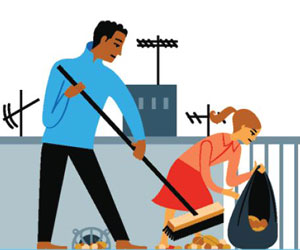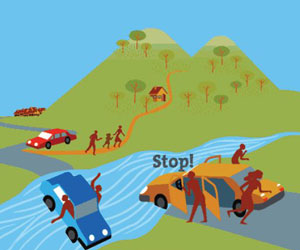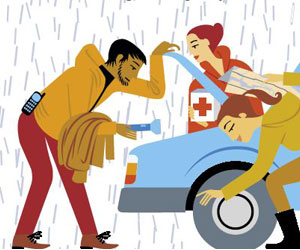
Home >
Floods and heavy downpours
Floods and heavy downpours
Heavy rainfall often causes serious damage and loss to both material and human life, particularly in the autumn. Water can appear unexpectedly and a lack of knowledge and carelessness are major causes of accidents. This is why we ask you to follow the advice on this page.

1. Stay informed in the event of an emergency.
- Listen to the radio for information: your local radio station, Catalunya RÓdio and Spanish National Radio.
- Pay careful attention to the weather forecasts and traffic information. If you need to travel, call 012 or check the website of the Catalan Traffic Service for information. .
- In an emergency, if you require assistance call 112 and always follow the instructions given by the authorities.

2. Take precautions before the rain season starts.
- Check where the main power switch and the water and gas valves are located in your home.
- Check the roof of your building regularly and ensure that the rainwater ducts and drains are kept clear, particularly those on patios and terraces on the tops of buildings.
- Keep useful items close by, such as a transistor radio, a torch, vital medication, warm clothes and personal documents.
- It is advisable to carry a torch, warm clothes, a first-aid kit, and a road map with you in the car.

3. Take care if you are caught out by major downpours.
- Take shelter in a safe building and close the doors and windows securely.
- Keep away from streams and torrents or areas that are liable to flooding and do not park your vehicle in these areas.
- Do not cross a river, stream or flooded area on foot or by car. You may be surprised to know that cars can easily float on and be swept away by relatively shallow water. Occupants of these vehicles frequently lose their lives. If your car begins to float or is swept along, get out immediately.
- Head for the highest point in the area.
- If you are travelling by car, try to use main routes and motorways and reduce your speed.
- If you experience visibility problems, pull over and alert other motorists as to your position.. If you require assistance call 012.

4. Take care of yourself at home or in a building.
- Do not go down to basements. Stay in high areas.
- Do not leave objects and furniture that may be swept away by water outside
- Close all the doors and windows and block as many gaps as possible.
- Place important documents, valuables, food, drinking water and, particularly, dangerous products in high and safe places. Lead pets to such places as well.
- Disconnect the main power supply.
- If you are not safe in the building you are in, leave the building, close the door and head for the area's high points.

5. If you need to leave your home, on leaving:
- Close all water and gas valves and disconnect the main power supply.
- Close and secure the doors and windows.
- Grab a pole, torch, suitable clothing and footwear and take documentation, money and medicines with you.
- Do not walk in areas where water is flowing and, if necessary, use your pole to see how deep the water is or to identify hazardous areas. Follow the instructions given by emergency teams.
When you return home once the danger has passed:
- Carry out a prior check in case there is a risk of the building collapsing.
- If you are not sure whether the water is drinkable, boil it or drink bottled water. Remove any dead animals quickly.
